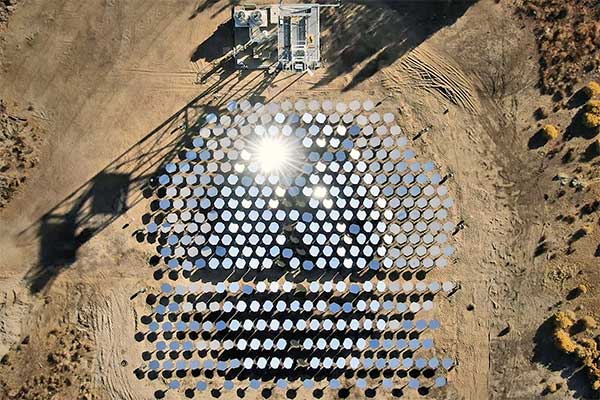The solar industry has grown tremendously in just a matter of years, primarily because of its knack for innovation. In the last decade, the efficiency and durability of solar panels has dramatically improved.
Subsequently, the cost of the technology has fallen significantly, improving the market strength of the industry. The pace of solar innovation remains rapid today, despite the Covid-19 pandemic. Below, we’ll take a look at five next-generation solar technologies, exploring which ones are ripe for market commercialization.
1. 2-D Printed Solar Panels

2-D Printed Solar Panels (Courtesy University of Newcastle).
Scientists at the University of Newcastle, Australia, have experimented with printing solar panels on bendable plastic film that’s only 0.1 millimetres thick. The film is made from polyethylene terephthalate, the same plastic used in soft drink bottles. As a result, traditional recycling processes could be used, drastically reducing costs. Researchers estimate that the 2-D panels will cost around $7.50 per square foot.
It’s important to note that 2-D printed panels aren’t competing with traditional PV panels as much as they are emerging solar roofs (ex. Tesla roof). University researchers haven’t released the information regarding these 2-D panels’ efficiency, but they’ve been clear that the selling point is versatility rather than sheer performance.
The 2-D printed panels are said to outperform traditional PV panels in lowlight conditions only, meaning roof orientation won’t be a constraining factor for their deployment. The panels are currently undergoing weather assessment tests to measure the technology’s durability, so commercial deployment is still several years away.
2. Concentrated Solar Technology

The Bill Gates-backed startup Heliogen has generated solar heat topping 1,000 degrees Celsius using mirrors. (Popular Mechanics)
Concentrated solar technology aims to replace fossil fuels in the world’s industrial plants — a daunting but essential challenge in the process of decarbonizing. One Los Angeles-based, Bill Gates-backed start-up, Heliogen, has experienced a breakthrough that the company believes will allow them to do just that.
Steel, cement, and petrochemical plants account for a sizeable chunk of the world’s greenhouse gas emissions. These industries require incredibly high temperatures (above 1000 degrees Celsius) in their production processes — temperatures that, up until this point, could only be achieved through the burning of hydrocarbon fuels. Attempts to decarbonize these industries using solar technology have occurred in the past, but they’ve failed to reach temperatures above 600 degrees. Past attempts at concentrated solar tried to predict where the sun would land. In contrast, Heliogen’s technology relies on cameras to track the sun and feed rapid, real-time instructions to attached mechanical cameras. This process has demonstrated itself to be far more reliable than traditional methods.
Heliogen expects its process to break temperatures of 1500 degrees Celsius, enough to produce green hydrogen through electrolysis. Hydrogen is the key to decarbonizing difficult sectors, and Heliogen might just have the technology to help it proliferate. Considering the success of its early tests, this technology will likely enter commercial markets in 2021 or shortly after.
3. Perovskite Coated Solar Panels (emerging in 2021)
Perovskite/silicon tandem solar cells are contenders for the next-generation photovoltaic technology, with the potential to deliver module efficiency gains at minimal cost. Researchers developed a new triple-halide perovskite alloy that enabled increased power conversion efficiency and photo stability (Dennis Schroeder, NREL)
Despite massive innovations in the industry, solar panels still only capture and convert around 20% of the sun’s rays. This is up from roughly 10% just ten years ago. Yet, as the rate of decarbonization quickens and electricity demand continues to rise, there’s a need for panel efficiency to be pushed even further.
An Oxford-based solar firm claims its next-generation solar panels, which are coated in perovskite, will increase panel efficiency by as much as one-third. Traditional silicon has served the solar industry well, but it’s reaching its theoretical max efficiency (as proven by the Shockley-Queisser limit). Perovskite can absorb more parts of the solar spectrum than silicon by itself, meaning much more efficient electricity production. In addition, perovskite changes the color of panels from blue to black, helping them blend into rooftops for customers wary of solar aesthetics.
The company’s initial tests proved successful, with efficiency rates of 27.3% being registered. This is far greater than panels currently on the market today, demonstrating the tremendous market potential behind this technology. Expect perovskite coated panels to break into the solar market in 2021.
4. Anti-Solar Panels

Nighttime photovoltaic cells: Researchers from the University of California, Davis, have announced a new invention that could harness solar power at night. (Graphic Representation)
This one may sound strange but bear with us for a moment. Photovoltaic panels are dependent on the amount of sun exposure they receive (obviously).
Anti-solar panels, introduced by researchers at the University of California, harness infrared energy primarily at night, rather than during the day. The panels collect heat radiating off the earth’s surface (known as radiative cooling) instead of collecting the sun’s energy. As the air grows colder during the nighttime, heat is emitted at greater levels from the earth’s surface.
Consequently, anti-solar panels are more efficient at the night time, though they do work 24/7. Radiative cooling would generate approximately one-quarter of traditional daytime panels’ capacity over the course of a night.
This may sound insignificant, but any technology that boosts the efficiency of solar energy is incredibly advantageous to the industry, as output is closely tied to cost-effectiveness and, therefore, commercial success. Prototypes are set to be built in 2021, meaning this product won’t be available in retail markets for a few years.
Regardless, this is a product to keep an eye on.
5. Solar Glass

Visible light doesn’t do anything on the glass. It just passes right through while the invisible infrared lights generate electricity (CNN).
Ubiquitous Energy, a California-based start-up, has engineered a solar coating capable of matching the transparency of standard windows. This is a revolutionary accomplishment, as it means the endless amounts of glass in the world’s skyscrapers and other buildings can become potential energy sources.
The solar coating is made from light-absorbing organic dyes, designed to absorb infrared light, which is converted into electricity. Visible light passes through the glass without any altercation, whereas the infrared light is trapped. Installations have already begun to pop up around the world in 2020, showing the level of excitement for this emerging technology.
Solar glass is less efficient than traditional photovoltaic panels, but much like 2-D printed panels, the real selling feature is versatility. Skyscrapers have much more available vertical space than rooftop space for electricity generation, meaning the products’ efficiency matters less. It should be noted that solar glass is not competing with rooftop panels; rather, it seeks to fill a complementary niche.
Combining rooftop panels and solar glass could allow skyscrapers and other energy-intensive buildings to offset a significant portion of their energy consumption, significantly reducing emissions.
—-
All these technologies offer promising additions to the already incredibly innovative solar industry. Out of all of them, solar glass, concentrated solar technology, and perovskite-coated solar panels look to be the fastest emerging.
Anti-solar and 2-D printed panels look promising, although they require more testing and research before they’ll be ready to hit commercial markets.
Regardless, the future of solar energy is bright, thanks to its commitment to forward-thinking research and development.










Comments